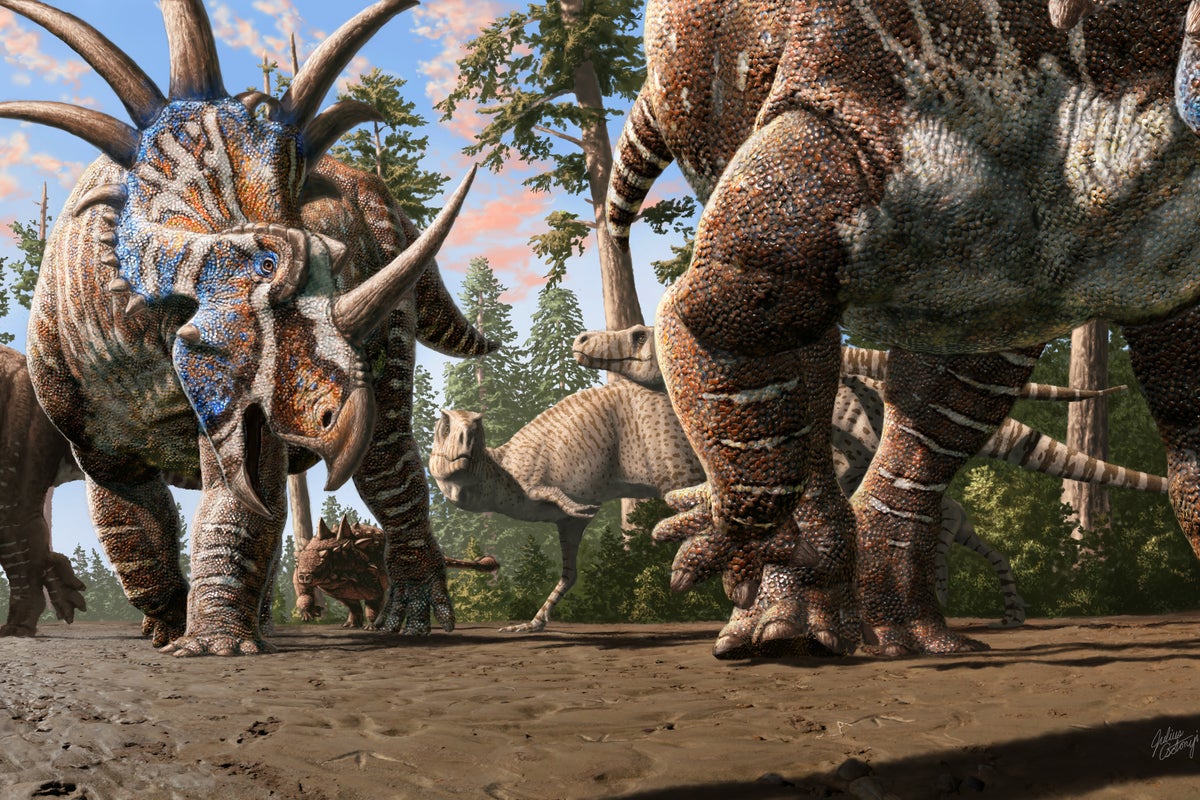Science
Fossil Footprints Unveil Multi-Species Herding Among Dinosaurs

Fossil footprints unearthed in Dinosaur Provincial Park, located in Alberta, Canada, provide groundbreaking evidence that different species of dinosaurs sometimes herded together, offering new insights into their social interactions. This discovery, detailed in the journal PLOS One, marks the first time researchers have documented mixed-species herding behavior among dinosaurs, akin to the way modern groups such as wildebeest and zebra coexist on the African plains.
Significant Findings at the Fossil Site
The research team, which includes scientists from the University of Reading in the UK, was particularly surprised to discover fossil tracks of two tyrannosaurs walking side by side, positioned perpendicular to the larger herd of multiple species. This observation suggests that such herding behavior may have served as a defensive strategy against common apex predators, including Tyrannosaurus rex.
During the excavation, researchers identified 13 horned dinosaur tracks attributed to at least five individuals traversing an area of approximately 30 square meters. Additionally, tracks from an armored dinosaur, likely an ankylosaurus, were found within the herd. Notably, evidence of a small carnivorous dinosaur was also present, enhancing the complexity of the ecological environment at the site.
Expert Insights and Future Research
Phil Bell, one of the study’s authors from the University of New England, expressed his fascination with the footprints, stating, “I’ve collected dinosaur bones in Dinosaur Provincial Park for nearly 20 years, but I’d never given footprints much thought. This rim of rock had the look of mud that had been squelched out between your toes, and I was immediately intrigued.” He further noted the chilling implication of the tyrannosaur tracks, which suggest these predators may have been observing the herd.
Brian Pickles, another author from the University of Reading, described the excitement of discovering the tracks, stating, “It was incredibly exciting to be walking in the footsteps of dinosaurs 76 million years after they laid them down.” He emphasized the potential for future digs at the site to reveal more about how different dinosaur species interacted and behaved in their natural habitats.
Caleb Brown, also part of the research team, highlighted the significance of the findings, saying, “Dinosaur Park is one of the best-understood dinosaur assemblages globally, with more than a century of intense collection and study, but it’s only now that we are getting a sense for its full potential for dinosaur trackways.”
The ongoing study of these fossil tracks promises to enrich our understanding of dinosaur behavior and social structures, illustrating a more complex picture of life during the Late Cretaceous period.
-

 Entertainment2 months ago
Entertainment2 months agoIconic 90s TV Show House Hits Market for £1.1 Million
-

 Lifestyle4 months ago
Lifestyle4 months agoMilk Bank Urges Mothers to Donate for Premature Babies’ Health
-

 Sports3 months ago
Sports3 months agoAlessia Russo Signs Long-Term Deal with Arsenal Ahead of WSL Season
-

 Lifestyle4 months ago
Lifestyle4 months agoShoppers Flock to Discounted Neck Pillow on Amazon for Travel Comfort
-

 Politics4 months ago
Politics4 months agoMuseums Body Critiques EHRC Proposals on Gender Facilities
-

 Business4 months ago
Business4 months agoTrump Visits Europe: Business, Politics, or Leisure?
-

 Lifestyle4 months ago
Lifestyle4 months agoJapanese Teen Sorato Shimizu Breaks U18 100m Record in 10 Seconds
-

 Politics4 months ago
Politics4 months agoCouple Shares Inspiring Love Story Defying Height Stereotypes
-

 World4 months ago
World4 months agoAnglian Water Raises Concerns Over Proposed AI Data Centre
-

 Sports4 months ago
Sports4 months agoBournemouth Dominates Everton with 3-0 Victory in Premier League Summer Series
-

 World4 months ago
World4 months agoWreckage of Missing Russian Passenger Plane Discovered in Flames
-

 Lifestyle4 months ago
Lifestyle4 months agoShoppers Rave About Roman’s £42 Midi Dress, Calling It ‘Elegant’









